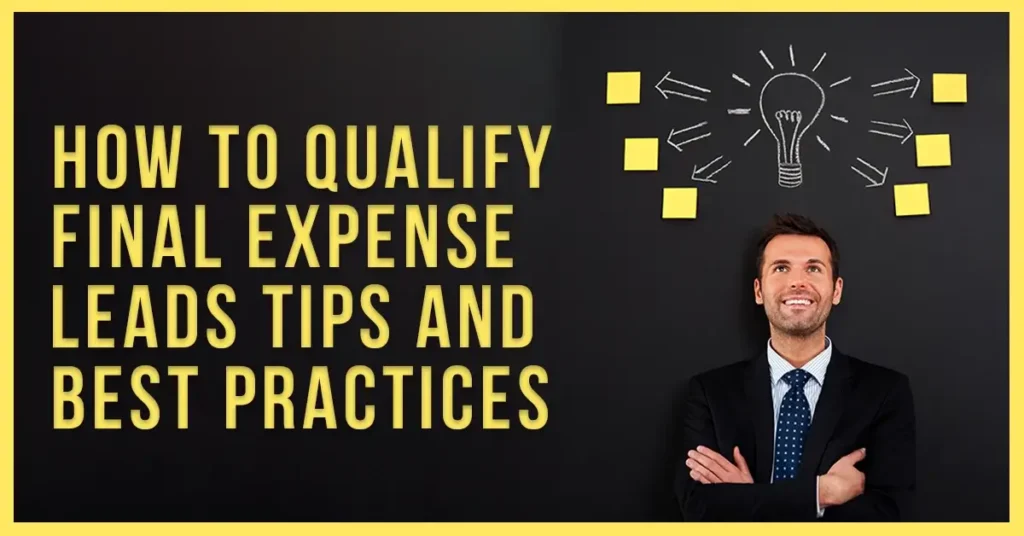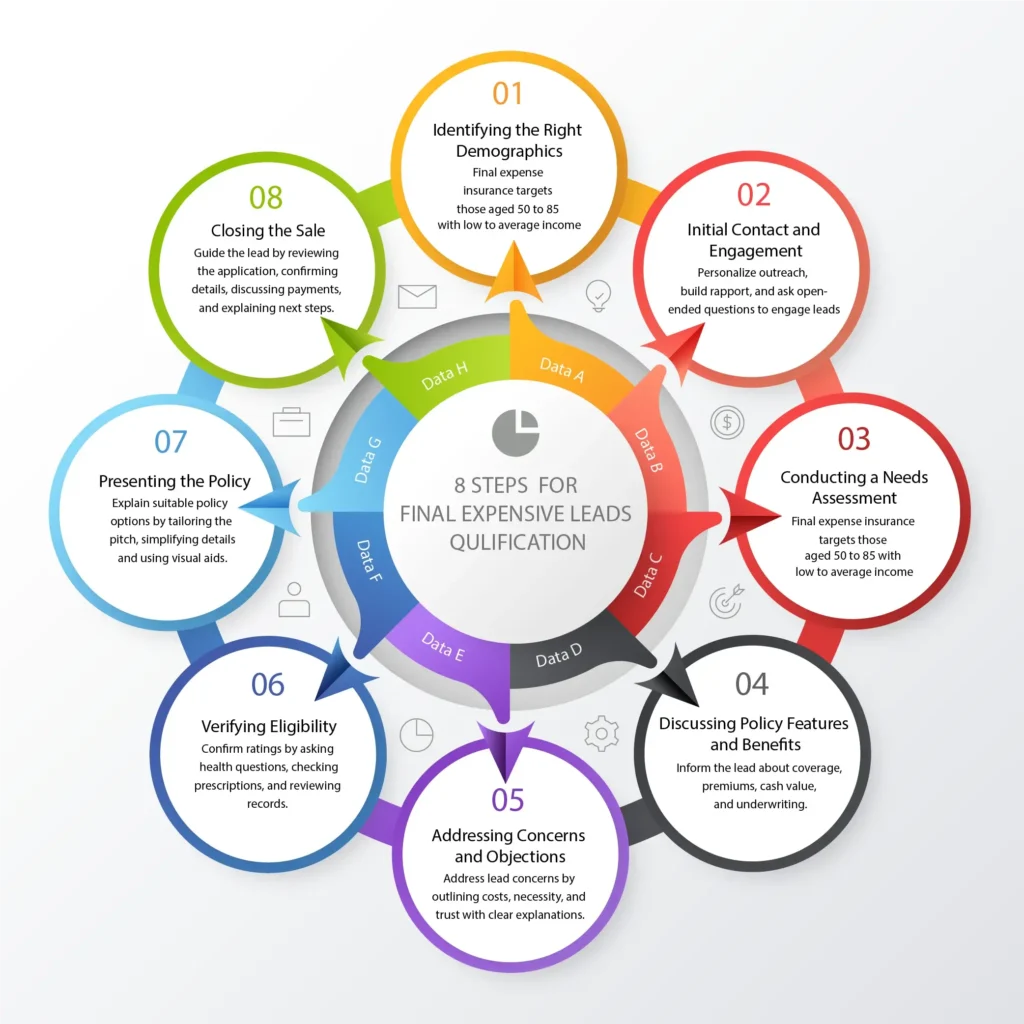
Do you want to know how to qualify final expense leads?
Do you want something easy and simple?
We have created this blog especially so you can understand how to qualify final expense leads.
We have mentioned several steps for your convenience so that you can understand them well. So read till the end!
Let’s begin:
Burial and funeral insurance, also called final expense insurance, is a relatively small, whole-life insurance policy created to pay for the funeral and certain other related expenses of the policyholder. For an insurance agent, it is vital to embrace strategies that ensure that the leads are well-appropriate to work with final expense policies. Qualifying leads saves costs and time, ensuring you target the right customers, and boosting sales and satisfaction.
This guide teaches you how to qualify final expense leads effectively.
Table of Contents
What is Final Expense Insurance?
It can also include funeral and burial costs and any costs associated with the medical treatment of the insured or his/her spouse, child, parent, or sibling. Ordinarily, these policies have small limits of insurance benefits that are usually between $5,000 and $25,000. With this policy, your payments stay the same while the policy’s value grows.
Who Needs Final Expense Insurance?
Most people buying final expense insurance are between 50 and 85, with limited funds for funeral costs. They want to protect loved ones from financial burdens. At the same time, it can be effective for younger people if they need it. These challenges often impact people with specific educational needs.
The Importance of Final Expense Lead Qualification:
Lead preprocessing is the act of eliminating unqualified prospects and instead identifying clients most probable to purchase a final expense insurance policy. Effective lead qualification helps in:
- Saving Time: Thus, agents can improve their activity concerning leads that are more likely to convert.
- Improving Conversion Rates: Such leads can be concluded to be more suitable for purchasing a policy hence enhancing overall sales.
- Enhancing Client Satisfaction: When the leads are a good fit, the chances of them going back dissatisfied and or not renewing their policy are slim.
- Optimizing Resources: Predictably qualified leads cut down on the cost of acquisition since prospects not on the qualified list are not targeted.
8 Steps To Qualify Final Expense Leads:

1. Identifying the Right Demographics:
It’s crucial to understand who typically needs final expense insurance. These policies are designed for people who may struggle to cover burial costs. Key factors include:
- Age: It’s revealed that final expense insurance is most popular among people 50 to 85 years of age.
- Income Level: Final expense insurance becomes favorable to most people, especially those with low to average earnings since it is cheap and it is specifically meant for final expenses.
- Health Status: Generally, final expense insurance does not involve extensive underwriting to determine the medical health status of a lead but where possible it is helpful if an insurer can find out about the lead’s health status to recommend suitable products.
2. Initial Contact and Engagement:
The first meeting with a lead is what sets the tone of the communication, and this is why. It lays the foundation and overall selling environment that forms the very basis of the sales campaign. Effective strategies include:
- Personalized Outreach: Start the conversation by acknowledging the lead by his or her name and mention any details that you have gathered through online or offline research concerning the lead.
- Building Rapport: First, try to have a friendly approach by appreciating their feelings and recognizing what they need.
- Open-Ended Questions: The appropriate probing questions for the lead should be those that elicit further details about the lead’s circumstances and issues.
3. Conducting a Needs Assessment:
To offer the right final expense insurance, we must first assess the lead’s needs. Key components include:
- Understanding Financial Situation: Can the lead afford premiums? Evaluate the financial position of the lead so that the company can know which class of policy to offer to him or her.
- Evaluating Existing Coverage: Determine if there are any preexisting life insurance policies and ensure that the funds available are enough to pay for the client’s burial expenses.
- Determining Final Expense Needs: Determine the lead’s perception and anticipation for how they want their funeral to be and the cost they are willing to incur.
4. Discussing Policy Features and Benefits:
Inform the lead about the existent final expense insurance products and their advantages. Important aspects to cover include:
- Coverage Amounts: Describe the open-ended coverage amounts and how they can be of help to the lead.
- Premiums: Explain fixed premiums and the procedures for not raising the premiums.
- Cash Value: Emphasize the policy’s cash value component and its possibilities of application.
- Simplified Underwriting: The remaining level of underwriting and the availability of coverage when discussing the generally low minimum qualifying standards?
5. Addressing Concerns and Objections:
Leads may likely have concerns or objections that they would want to be clarified. Common issues include:
- Cost: A few leads may have to consider the cost of premiums an issue of concern. Outline the general costs and available payment procedures.
- Necessity: Some people are likely to argue that final expense insurance is not necessary especially if they have savings or other insurance products. Final expense insurance explains the funeral expense insurance process step by step, by which specific funds are designated for a funeral, to maintain other assets intact.
- Trust: The trust factor is very important. Provide experiences of fellow customers and the general rating of the insurance company.
6. Verifying Eligibility:
Leading final expense insurance has reduced medical rating which should however be confirmed. Key steps include:
- Health Questions: Question the lead about his or her health status and any chronic ailments.
- Prescription Check: Some policies may also involve a prescription drug history check to determine the patient’s qualification for such policies.
- Medical Records: Thus, in some cases, it may be useful to get a patient’s records or perform a simple examination.
7. Presenting the Policy:
After determining the potential buyer’s eligibility to purchase the policy, and after understanding the client’s needs, explain the available policy options that suit their case. Ensure to:
- Tailor the Presentation: Whenever you need to make a presentation in front of the lead, try to design your pitch in such a way that would allow you to focus on the functions and values that the lead would appreciate.
- Clear Explanations: To ensure the policy details are understood by the target demographic, the language used should not be complex or technical.
- Visual Aids: The use of brochures, charts, and other items should be made quickly to enable the lead to understand the policy.
8. Closing the Sale:
It entails leading the lead to the policy sale and knowing the various stages that one has to take to make the sale. Effective strategies include:
- Reviewing the Application: Help the lead fill in the application form as per his or her information and as guided by the lead herself or himself.
- Confirming Details: Be careful with all the details and ensure they are correct to avoid delay problems.
- Payment Options: This will entail a discussion and setting up the preferred payment method when paying for premiums.
- Next Steps: This covers what happens after you apply, including policy details and customer support.
Advanced Techniques To Qualify Final Expense Leads:
1. Leveraging Technology:
It was ascertained that the application of technologies can boost lead qualification mechanisms remarkably. Key tools and strategies include:
- CRM Systems: Regarding the leads customer relationship management (CRM) systems must be implemented and properly utilized.
- Lead Scoring: Develop the models of lead scoring to categorize the potential buyers with the intent to make a purchase.
- Automation: Use follow-ups and reminders for performance optimization since they can be easily batch-processed.
- Data Analytics: Review information collected to find out the characteristics that would help in enhancing the lead qualification.
2. Behavioral Insights:
Knowledge of leads’ behavior might be useful when it comes to their qualification. Techniques include:
- Website Analytics: Pay attention to how a lead behaves on a website to be in a position to know whether he/or she has a high interest.
- Email Engagement: Monitor the response rate in terms of the number of opens and clicks as well as responses to determine the lead interest.
- Social Media Interactions: Monitor leads’ activity on social networks to identify what they care about and what they are indifferent to.
3. Continuous Training and Development:
Investing in ongoing training for agents ensures they remain skilled and knowledgeable. Focus areas include:
- Sales Techniques: Regular training on effective sales techniques and communication skills.
- Product Knowledge; Keeping agents updated on the latest policy features and industry trends.
- Regulatory Compliance: Ensuring agents are aware of and comply with all relevant regulations and ethical standards.
Challenges While Qualify Final Expense Leads:
1. Common Obstacles:
Qualifying final expense leads can present several challenges, including:
- Skepticism and Mistrust: Some of the leads are likely to be very cautious with insurance sales hence one may need to work a little more in convincing them.
- Health Issues: However, it is also understood that some of the leads might have some health issues that would help them qualify for a loan.
- Financial Constraints: There is the issue of high costs where a leader with little capital may not afford premium costs.
- Complex Needs: This is most especially the case if the leader is involved in handling complex financial situations where more elaborate evaluations and solutions might be expected.
2. Overcoming Challenges:
Strategies to overcome these challenges include:
- Building Rapport: Spend time engaging leads the way real friends would do so instead of working the closing tactics.
- Clear Communication: Assert your views and worries as straightforward and sincere to agree with the other party.
- Flexible Solutions: Explain that there are many options regarding payment, policy, and to be ready for those who do not have the required amount of money at the moment.
- Comprehensive Training: It is crucial to train the agents so that they are fit for purpose and can cope with the consequences of different tests and scenarios.
Conclusion – Qualify Final Expense Leads:
Remember to always qualify free leads for final expense thoroughly to ensure successful sales and satisfied clients. Understanding the demographics of your target audience is key, so take the time to engage with leads effectively and conduct thorough needs assessments. Embracing technological tools and resources can also go a long way in improving your lead qualification processes. To succeed, focus on clear communication, building trust, and offering flexible solutions to overcome challenges and convert more leads. By implementing these strategies, insurance agents can effectively master the art of lead qualification and connect with the right clients for final expense insurance.
FREQUENTLY ASKED QUESTIONS:
Q: What is the difference between life insurance and final expenses?
Traditional life insurance tackles long-term needs like replacing lost income, paying off debts, and funding education. Final expense insurance focuses solely on end-of-life expenses like funerals, with a smaller death benefit to reflect this specific purpose.
Q: Who qualifies for leads?
Marketing and sales teams qualify leads to try and figure out how likely a prospect is to buy something from their company. This tends to be a multi-stage process. The very best sales teams are continually qualifying their leads to ensure that they’re spending their time in the best manner possible.
